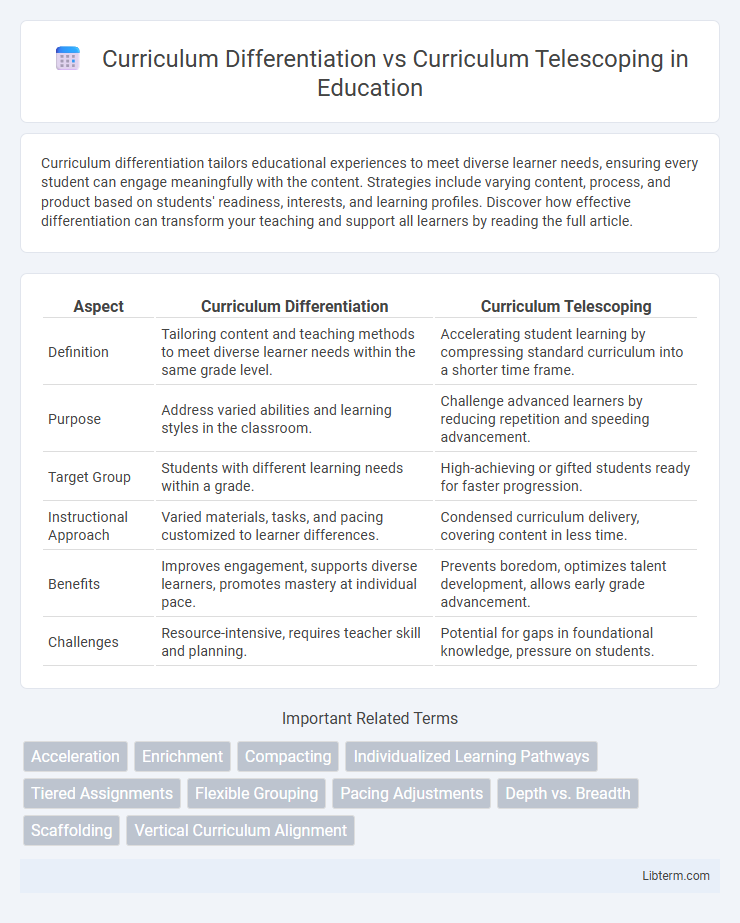Curriculum differentiation tailors educational experiences to meet diverse learner needs, ensuring every student can engage meaningfully with the content. Strategies include varying content, process, and product based on students' readiness, interests, and learning profiles. Discover how effective differentiation can transform your teaching and support all learners by reading the full article.
Table of Comparison
| Aspect | Curriculum Differentiation | Curriculum Telescoping |
|---|---|---|
| Definition | Tailoring content and teaching methods to meet diverse learner needs within the same grade level. | Accelerating student learning by compressing standard curriculum into a shorter time frame. |
| Purpose | Address varied abilities and learning styles in the classroom. | Challenge advanced learners by reducing repetition and speeding advancement. |
| Target Group | Students with different learning needs within a grade. | High-achieving or gifted students ready for faster progression. |
| Instructional Approach | Varied materials, tasks, and pacing customized to learner differences. | Condensed curriculum delivery, covering content in less time. |
| Benefits | Improves engagement, supports diverse learners, promotes mastery at individual pace. | Prevents boredom, optimizes talent development, allows early grade advancement. |
| Challenges | Resource-intensive, requires teacher skill and planning. | Potential for gaps in foundational knowledge, pressure on students. |
Introduction to Curriculum Differentiation and Curriculum Telescoping
Curriculum differentiation involves tailoring educational content, processes, and products to meet diverse student needs, abilities, and interests, enhancing engagement and learning outcomes. Curriculum telescoping accelerates learning by condensing standard content into a shorter time frame, catering to advanced learners who can progress beyond conventional pacing. Both approaches aim to optimize curriculum delivery but differ in method: differentiation adapts to individual learning differences while telescoping compresses the curriculum for accelerated mastery.
Defining Curriculum Differentiation
Curriculum Differentiation involves tailoring educational content, process, and products to meet diverse learners' needs, abilities, and interests within the same classroom. It ensures that all students access appropriate challenges by modifying instruction without changing the overall curriculum objectives. Unlike Curriculum Telescoping, which accelerates learning pace for advanced students, Curriculum Differentiation emphasizes individualized strategies within standard timelines.
Understanding Curriculum Telescoping
Curriculum telescoping involves accelerating students through educational content at a faster pace by condensing the curriculum, allowing learners to complete standard coursework in a shorter time frame. This approach contrasts with curriculum differentiation, which adapts the content, process, and product to meet diverse learner needs without necessarily altering the overall timeline. Understanding curriculum telescoping is crucial for implementing effective acceleration strategies that address the needs of advanced students without compromising educational quality.
Key Differences Between Differentiation and Telescoping
Curriculum Differentiation customizes instructional content and learning processes to address diverse student needs, allowing varied pacing and complexity within the same grade level. Curriculum Telescoping accelerates the standard curriculum by compressing the content, enabling advanced learners to complete coursework in less time than usual. Key differences include differentiation's emphasis on individualized learning pathways versus telescoping's focus on expedited curriculum completion.
Pedagogical Goals of Each Approach
Curriculum differentiation aims to address diverse learner needs by providing varied content, processes, and products tailored to students' readiness, interests, and learning profiles, enhancing engagement and mastery. Curriculum telescoping offers an accelerated pacing system that compacts standard curriculum into a shorter timeframe, targeting gifted or advanced learners to deepen knowledge and stimulate intellectual growth. Both approaches prioritize optimizing educational outcomes but differ in focus, with differentiation emphasizing personalized learning pathways and telescoping promoting accelerated progression.
Benefits of Curriculum Differentiation
Curriculum differentiation enhances student engagement by tailoring learning experiences to diverse abilities, interests, and learning styles, promoting individualized academic growth. It supports inclusive education, allowing teachers to address varied skill levels within a single classroom, which improves overall student achievement and motivation. By fostering personalized learning pathways, curriculum differentiation helps develop critical thinking and problem-solving skills, preparing students for diverse educational and career challenges.
Advantages of Curriculum Telescoping
Curriculum telescoping offers the advantage of accelerating students who demonstrate advanced understanding, allowing them to complete educational milestones in a shorter timeframe. This approach maximizes learning efficiency by tailoring pace to individual capabilities, preventing boredom and disengagement among gifted learners. It also supports early exposure to higher-level academic challenges, promoting intellectual growth and motivation.
Challenges and Limitations of Both Methods
Curriculum differentiation faces challenges in maintaining equitable learning outcomes due to the increased demand on teacher time and resources to tailor content for diverse student needs, which can lead to inconsistent implementation and potential gaps in knowledge. Curriculum telescoping often encounters limitations related to excessive academic pressure on gifted students, risking burnout and social-emotional issues as it accelerates content without adequate support systems. Both methods require careful balancing of individualized learning benefits against practical constraints in educational settings, including teacher training and curriculum design flexibility.
Criteria for Selecting the Right Approach
Curriculum differentiation is best selected when student readiness, learning styles, and interests vary significantly, requiring tailored instruction to meet diverse needs. Curriculum telescoping suits advanced learners demonstrating accelerated mastery, enabling compression of content without sacrificing depth. Effective criteria for choosing between these approaches include student achievement levels, cognitive abilities, and instructional goals aligned with curriculum standards.
Conclusion: Choosing the Best Fit for Learners
Curriculum differentiation offers personalized learning paths by adjusting content, process, and product to meet diverse learner needs, enhancing engagement and comprehension. Curriculum telescoping accelerates the pace, allowing advanced learners to complete standard curricula faster, which benefits gifted students seeking challenge and depth. Selecting the best fit depends on learner profiles, with differentiation suited for varied abilities and telescoping ideal for gifted individuals requiring expedited progression.
Curriculum Differentiation Infographic

 libterm.com
libterm.com